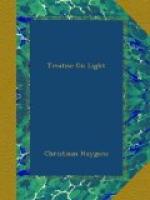I have also stated in the preceding demonstration that the movement of the piece A of the incident wave is not able to communicate itself beyond the plane ab, or at least not wholly. Whence it is to be remarked that though the movement of the ethereal matter might communicate itself partly to that of the reflecting body, this could in nothing alter the velocity of progression of the waves, on which the angle of reflexion depends. For a slight percussion ought to generate waves as rapid as strong percussion in the same matter. This comes about from the property of bodies which act as springs, of which we have spoken above; namely that whether compressed little or much they recoil in equal times. Equally so in every reflexion of the light, against whatever body it may be, the angles of reflexion and incidence ought to be equal notwithstanding that the body might be of such a nature that it takes away a portion of the movement made by the incident light. And experiment shows that in fact there is no polished body the reflexion of which does not follow this rule.
But the thing to be above all remarked in our demonstration is that it does not require that the reflecting surface should be considered as a uniform plane, as has been supposed by all those who have tried to explain the effects of reflexion; but only an evenness such as may be attained by the particles of the matter of the reflecting body being set near to one another; which particles are larger than those of the ethereal matter, as will appear by what we shall say in treating of the transparency and opacity of bodies. For the surface consisting thus of particles put together, and the ethereal particles being above, and smaller, it is evident that one could not demonstrate the equality of the angles of incidence and reflexion by similitude to that which happens to a ball thrown against a wall, of which writers have always made use. In our way, on the other hand, the thing is explained without difficulty. For the smallness of the particles of quicksilver, for example, being such that one must conceive millions of them, in the smallest visible surface proposed, arranged like a heap of grains of sand which has been flattened as much as it is capable of being, this surface then becomes for our purpose as even as a polished glass is: and, although it always remains rough with respect to the particles of the Ether it is evident that the centres of all the particular spheres of reflexion, of which we have spoken, are almost in one uniform plane, and that thus the common tangent can fit to them as perfectly as is requisite for the production of light. And this alone is requisite, in our method of demonstration, to cause equality of the said angles without the remainder of the movement reflected from all parts being able to produce any contrary effect.
CHAPTER III
ON REFRACTION




